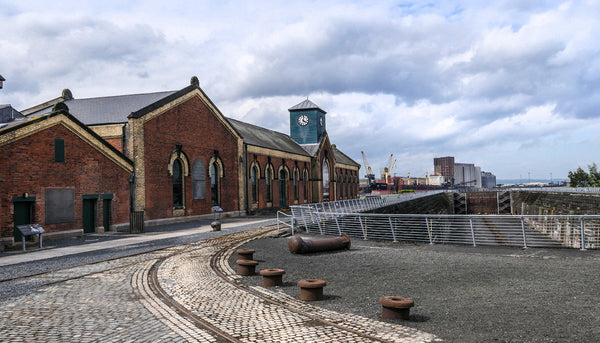
EXPLORE
THOMPSON DOCK
In the heart of the Maritime Mile, where the Titanic once stood is Thompson Dock and Pumphouse - the home of Titanic Distillers.

THE BIRTHPLACE OF TITANIC
Thompson Graving Dock is located on the west-side of Queen's Island in Belfast, within sight of Harland and Wolff shipyard. The dock was constructed by the Belfast Harbour Commissioners, opened in 1911 and named after the Chairman of the Commission, Robert Thompson . It was designed to accommodate the new mammoth White Star liners, Olympic and Titanic.
Learn More About Thompson Dock and Pumphouse
Following the launch of Titanic's hull on 31 May 1911, the empty hull was moved to Thompson Dry Dock for fit-out, painting and installation of the propellers.
The adjacent building is the dock's Pumphouse and was used to pump out water from the dock. The Pumphouse originally served the Alexandra Graving Dock, located on the other side of the Pumphouse from the Thompson Graving Dock, and was extended to provide additional pumping capacity for the new Thompson Graving Dock. The powerful pumps were able to drain Thompson Dock of 26m imperial gallons of water in just 90 minutes - a rate of 2 swimming pools per minute.
Today, the dock is the only location where it is possible to properly gauge the scale of the Titanic, as the whole footprint of the graving dock would have been occupied by the hull of the ship. The Pumphouse serves as a heritage attraction telling the story of the dock and the Titanic.
The dock is 850 feet (259 metres) in length, to fit - the largest liners in the world at that time.
The width of the dock floor measures 100 feet (30.48 metres), while at the caisson gate the width is 96 feet (29.26 metres), giving a margin of just 1 foot 9 inches (0.53 metres) either side of the dock gate for the transit of the Titanic.
The graving dock was a dry dock; the dock would be flooded to allow a ship to enter the dock. The caisson gate to the dock would be closed and the dock pumped dry. The ship had to be positioned exactly, so that she would come to rest on the keel blocks.

The machinery that facilitated such a powerful operation is to be found in the Pumphouse alongside the dock. This building is a fine example of late Victorian architecture: red bricks with a cream façade, great arched windows and a handsome clock tower.
Remaining in use until 2002, Thompson Graving Dock saw many ships pass through, the most famous of course being RMS Titanic. Following the liner’s launch from the slipways on 31st May 1911, she was warped into the dry dock for fitting out before departing Belfast to set off on her maiden voyage in April 1912.
Titanic Distillers is inspired by the people who worked in Belfast’s shipyard more than a century ago – and now tourists will be able to walk in their footsteps in the very pump-house and dry dock that represent such an authentic part of the Titanic story and indeed the history of Belfast.
The Pumphouse has survived remarkably well for more than 100 years in a very harsh environment but was in much need of repair and a major risk to its future – so our first priority was to restore the building and bring it back to its former glory while maintaining and securing its long-term future.
Visitors to the Pumphouse will clock in, as workers did a century ago, to view the workings of the distillery and hear the story of Belfast’s whiskey tradition, why it disappeared and how it has returned with the city’s first working whiskey distillery in almost 90 years.


